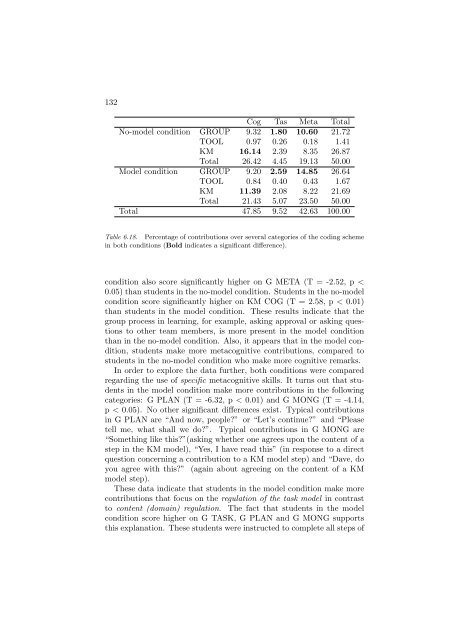The role of metacognitive skills in learning to solve problems
The role of metacognitive skills in learning to solve problems
The role of metacognitive skills in learning to solve problems
You also want an ePaper? Increase the reach of your titles
YUMPU automatically turns print PDFs into web optimized ePapers that Google loves.
132<br />
Cog Tas Meta Total<br />
No-model condition GROUP 9.32 1.80 10.60 21.72<br />
TOOL 0.97 0.26 0.18 1.41<br />
KM 16.14 2.39 8.35 26.87<br />
Total 26.42 4.45 19.13 50.00<br />
Model condition GROUP 9.20 2.59 14.85 26.64<br />
TOOL 0.84 0.40 0.43 1.67<br />
KM 11.39 2.08 8.22 21.69<br />
Total 21.43 5.07 23.50 50.00<br />
Total 47.85 9.52 42.63 100.00<br />
Table 6.18. Percentage <strong>of</strong> contributions over several categories <strong>of</strong> the cod<strong>in</strong>g scheme<br />
<strong>in</strong> both conditions (Bold <strong>in</strong>dicates a significant difference).<br />
condition also score significantly higher on G META (T = -2.52, p <<br />
0.05) than students <strong>in</strong> the no-model condition. Students <strong>in</strong> the no-model<br />
condition score significantly higher on KM COG (T = 2.58, p < 0.01)<br />
than students <strong>in</strong> the model condition. <strong>The</strong>se results <strong>in</strong>dicate that the<br />
group process <strong>in</strong> learn<strong>in</strong>g, for example, ask<strong>in</strong>g approval or ask<strong>in</strong>g questions<br />
<strong>to</strong> other team members, is more present <strong>in</strong> the model condition<br />
than <strong>in</strong> the no-model condition. Also, it appears that <strong>in</strong> the model condition,<br />
students make more <strong>metacognitive</strong> contributions, compared <strong>to</strong><br />
students <strong>in</strong> the no-model condition who make more cognitive remarks.<br />
In order <strong>to</strong> explore the data further, both conditions were compared<br />
regard<strong>in</strong>g the use <strong>of</strong> specific <strong>metacognitive</strong> <strong>skills</strong>. It turns out that students<br />
<strong>in</strong> the model condition make more contributions <strong>in</strong> the follow<strong>in</strong>g<br />
categories: G PLAN (T = -6.32, p < 0.01) and G MONG (T = -4.14,<br />
p < 0.05). No other significant differences exist. Typical contributions<br />
<strong>in</strong> G PLAN are “And now, people?” or “Let’s cont<strong>in</strong>ue?” and “Please<br />
tell me, what shall we do?”. Typical contributions <strong>in</strong> G MONG are<br />
“Someth<strong>in</strong>g like this?”(ask<strong>in</strong>g whether one agrees upon the content <strong>of</strong> a<br />
step <strong>in</strong> the KM model), “Yes, I have read this” (<strong>in</strong> response <strong>to</strong> a direct<br />
question concern<strong>in</strong>g a contribution <strong>to</strong> a KM model step) and “Dave, do<br />
you agree with this?” (aga<strong>in</strong> about agree<strong>in</strong>g on the content <strong>of</strong> a KM<br />
model step).<br />
<strong>The</strong>se data <strong>in</strong>dicate that students <strong>in</strong> the model condition make more<br />
contributions that focus on the regulation <strong>of</strong> the task model <strong>in</strong> contrast<br />
<strong>to</strong> content (doma<strong>in</strong>) regulation. <strong>The</strong> fact that students <strong>in</strong> the model<br />
condition score higher on G TASK, G PLAN and G MONG supports<br />
this explanation. <strong>The</strong>se students were <strong>in</strong>structed <strong>to</strong> complete all steps <strong>of</strong>
















